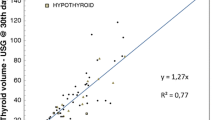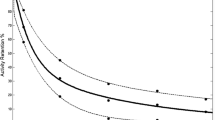Abstract
Objective
Pre-therapeutic blood dosimetry prior to a high-dose radioiodine therapy (RAIT) is recommended and a blood dose of 2 Gy is considered to be safe. In this study, changes in the blood cell count after radioiodine therapy of high risk differentiated thyroid carcinoma (DTC) were analyzed and compared with the results of the pre-therapeutic blood dosimetry using 124I. Moreover, the influence of different modes of TSH stimulation and the number of preceding radioiodine therapies on the blood dose were assessed.
Methods
198 patients with locally advanced or metastasized DTC received a pre-therapeutic blood dosimetry using 124I. To analyze the influence of the modes of TSH stimulation and the number of preceding RAITs on blood dose subgroups were built as follows: patients with endogenous TSH stimulation versus patients with exogenous TSH stimulation and patients with no preceding RAIT versus patients with at least one preceding RAIT. In 124/198 patients subsequent RAIT was performed. In 73/124 patients, hemograms were performed from day 2 to 12 month after RAIT.
Results
There was no high-grade bone marrow toxicity (i.e. ≥grade 3) in patients receiving less than 2 Gy blood dose—independent of the therapeutic history. Within the first month after radioiodine therapy, there was an overall decrease in the white blood cell and platelet counts. The erythrocyte count was essentially stable. There was a correlation between cell count decrease and predicted blood doses (Spearman’s correlation coefficient >−0.6 each) for the white cell line and the platelets. With regard to the subgroups, the blood dose per administered 131I activity (BDpA) was significantly higher in patients with endogenous TSH stimulation (median 0.08 Gy/GBq) than in patients with exogenous TSH stimulation (0.06 Gy/GBq) and in patients with no previous RAIT (0.08 Gy/GBq) compared to patients who had previously undergone at least one RAIT (0.07 Gy/GBq).
Conclusions
The range of BDpA among DTC patients is rather wide. Our results suggest that lower blood doses can be expected when using exogenous TSH stimulation and blood doses are generally higher at first RAIT compared to subsequent RAITs. Thus, we advise to make blood dosimetry standard praxis prior to a high-activity RAIT.


Similar content being viewed by others

References
Dietlein M, Dressler J, Eschner W, Grunwald F, Lassmann M, Leisner B, et al. Procedure guidelines for radioiodine therapy of differentiated thyroid cancer (version 3). Nuklearmedizin. 2007;46:213–9. (Article in German).
Luster M, Clarke SE, Dietlein M, Lassmann M, Lind P, Oyen WJG, et al. Guidelines for radioiodine therapy of differentiated thyroid cancer. Eur J Nucl Med Mol Imaging. 2008;35(10):1941–59.
Kulkarni K, van Nostrand D, Atkins F, Aiken M, Burman K, Wartofsky L. The relative frequency in which empiric dosages of radioiodine would potentially overtreat or undertreat patients who have metastatic well-differentiated thyroid cancer. Thyroid. 2006;16:1019–23.
Lassmann M, Hänscheid H, Chiesa C, Hindorf C, Flux G, Luster M, et al. EANM Dosimetry Committee series on standard operational procedures for pre-therapeutic dosimetry I: blood and bone marrow dosimetry in differentiated thyroid cancer therapy. Eur J Nucl Med Mol Imaging. 2008;35:1405–12.
Benua RS, Cicale NR, Sonenberg M, Rawson RW. The relation of radioiodine dosimetry to results and complications in the treatment of metastatic thyroid cancer. Am J Roentgenol Radium Ther Nucl Med. 1962;87:171–82.
Benua RS, Leeper RD. A method and rationale for treating metastatic thyroid carcinoma with the largest safe dose of I-131. In: Medeiros-Neto G, Gaitan G, editors. Frontiers in thyroidology. New York: Plenum Medical Book Co; 1986. p. 1317–21.
Erdi YE, Macapinlac H, Larson SM, Erdi AK, Yeung H, Furhang EE, et al. Radiation dose assessment for I-131 therapy of thyroid cancer using I-124 PET imaging. Clin Positron Imaging. 1999;2(1):41–6.
Furhang EE, Larson SM, Buranapong P, Humm JL. Thyroid cancer dosimetry using clearance fitting. J Nucl Med. 1999;40(1):131–6.
Jentzen W, Freudenberg L, Eising EG, Sonnenschein W, Knust J, Bockisch A. Optimized 124I PET dosimetry protocol for radioiodine therapy of differentiated thyroid cancer. J Nucl Med. 2008;49(6):1017–23.
Common Toxicity Criteria Version 3.0. Cancer Therapy Evaluation Program. DCTD, National Cancer Institute, NIH, DHHS. August 2006.
Verburg FA, Hänscheid H, Biko J, Hategan MC, Lassmann M, Kreissl MC, et al. Dosimetry-guided high-activity (131)I therapy in patients with advanced differentiated thyroid carcinoma: initial experience. Eur J Nucl Med Mol Imaging. 2010;37(5):896–903.
de Keizer B, Hoekstra A, Konijnenberg MW, de Vos F, Lambert B, van Rijk PP, et al. Bone marrow dosimetry and safety of high 131I activities given after recombinant human thyroid-stimulating hormone to treat metastatic differentiated thyroid cancer. J Nucl Med. 2004;45(9):1549–54.
Dorn R, Kopp J, Vogt H, Heidenreich P, Carroll RG, Gulec SA. Dosimetry-guided radioactive iodine treatment in patients with metastatic differentiated thyroid cancer: largest safe dose using a risk-adapted approach. J Nucl Med. 2003;44:451–6.
Grunwald F, Schomburg A, Menzel C, Steinecker S, Späth G, Bockisch A, et al. Changes in the blood picture after radioiodine therapy of thyroid cancer. Med Klin (Munich). 1994;89:522–8. (article in German).
Chow SM. Side effects of high-dose radioactive iodine for ablation or treatment of differentiated thyroid carcinoma. J HK Coll Radiol. 2005;8:127–35.
Tuttle RM, Leboeuf R, Robbins RJ, Qualey R, Pentlow K, Larson SM, Chan CY. Empiric radioactive iodine dosing regimens frequently exceed maximum tolerated activity levels in elderly patients with thyroid cancer. J Nucl Med. 2006;47:1587–91.
Hlad CJ Jr, Bricker NS. Renal function and I-131 clearance in hyperthyroidism and myxedema. J Clin Endocrinol Metab. 1954;14:1539–50.
Montenegro J, González O, Saracho R, Aguirre R, González O, Martínez I. Changes in renal function in primary hypothyroidism. Am J Kidney Dis. 1996;27(2):195–8.
Pacini F, Ladenson PW, Schlumberger M, Driedger A, Luster M, Kloos RT, et al. Radioiodine ablation of thyroid remnants after preparation with recombinant human thyrotropin in differentiated thyroid carcinoma: results of an international, randomized, controlled study. J Clin Endocrinol Metab. 2006;91(3):926–32.
Freudenberg LS, Jentzen W, Petrich T, Frömke C, Marlowe RJ, Heusner T, et al. Lesion dose in differentiated thyroid carcinoma metastases after rhTSH or thyroid hormone withdrawal: 124I PET/CT dosimetric comparisons. Eur J Nucl Med Mol Imaging. 2010;37:2267–76.
Conflict of interest
No potential conflicts of interest were disclosed.
Author information
Authors and Affiliations
Corresponding author
Rights and permissions
About this article
Cite this article
Hartung-Knemeyer, V., Nagarajah, J., Jentzen, W. et al. Pre-therapeutic blood dosimetry in patients with differentiated thyroid carcinoma using 124-iodine: predicted blood doses correlate with changes in blood cell counts after radioiodine therapy and depend on modes of TSH stimulation and number of preceding radioiodine therapies. Ann Nucl Med 26, 723–729 (2012). https://doi.org/10.1007/s12149-012-0632-1
Received:
Accepted:
Published:
Issue Date:
DOI: https://doi.org/10.1007/s12149-012-0632-1



